The Mauke starling or mysterious starling is an extinct species of starling found on the island of Mauke, Cook Islands. The binomen is the result of Buller's misreading of the name inornata on the specimen label. As he seems to have genuinely believed this spelling to be correct, the binomial, although it has no meaning, is valid.

Aplonis is a genus of starlings. These are essentially island species of Indonesia and Oceania, although some species' ranges extend to the Malay Peninsula, southern Vietnam and northeastern Queensland. The typical adult Aplonis starling is fairly uniformly plumaged in black, brown or dark green, sometimes with a metallic gloss. The eye ring is often distinctively coloured. Immatures of several species have dark streaked pale underparts.
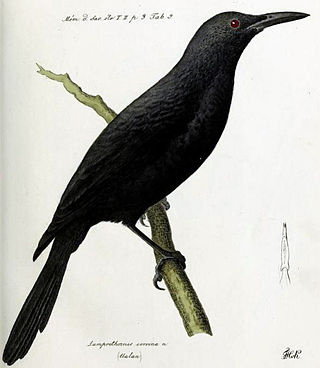
The Kosrae starling, also known as Kosrae Island starling, and formerly as Kusaie Mountain starling, is an extinct bird from the family of starlings (Sturnidae). It was endemic to the montane forests on the island of Kosrae which belong to the Caroline Islands in the south-western Pacific.
The Tasman starling was described in 1836 by John Gould as a species which occurred on both Norfolk Island and Lord Howe Island. In 1928 Australian ornithologist Gregory Mathews recognized that the plumage of the race from Lord Howe Island was much browner and more greyish than the plumage of the Norfolk Island race and split the species into two forms, the Norfolk starling, and the Lord Howe starling. Both subspecies are now extinct, thus so the species.
The white-eyed starling is a species of starling in the family Sturnidae. It is found in the Solomon Islands archipelago. Its natural habitats are subtropical or tropical moist lowland forests and subtropical or tropical swamps. It is threatened by habitat loss.

The Rarotonga starling is a species of starling in the family Sturnidae. It is endemic to the Cook Islands.

The Tanimbar starling is a species of starling in the family Sturnidae. It is endemic to Indonesia.
The Makira starling, also known as the San Cristobal starling, is a species of starling in the family Sturnidae. It is endemic to the Solomon Islands. Its natural habitat is subtropical or tropical moist lowland forests.

The atoll starling is a species of starling in the family Sturnidae. It is found in northern Melanesia: Green Islands, Nuguria, Ninigo, Hermit Islands and Ontong Java Atoll. Its natural habitat is subtropical or tropical moist lowland forests. The species apparently nests in holes in trees. It is threatened by habitat loss.
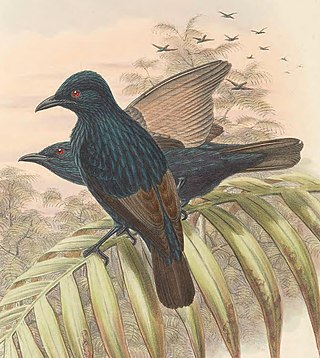
The brown-winged starling is a species of starling in the family Sturnidae. It is found in the Solomon Islands archipelago. Its natural habitat is subtropical or tropical moist lowland forests.

The long-tailed starling is a species of starling in the family Sturnidae. It is endemic to the Schouten Islands off West Papua, in Indonesia, an important area of bird endemism. The species was once treated as part of a superspecies with the shining starling. There are two subspecies, the nominate race, which occurs on Biak, and brevicauda, which is found on Numfor Island. It occurs in a wide range of habitats at all altitudes, including natural forest and forest edges, as well as human modified secondary forests and gardens. In spite of its tiny global range the species is not considered threatened by human activities and remains common within its range, and is therefore listed as least concern by the IUCN.

The short-tailed starling is a species of starling in the family Sturnidae. It is found in Indonesia and the Philippines.
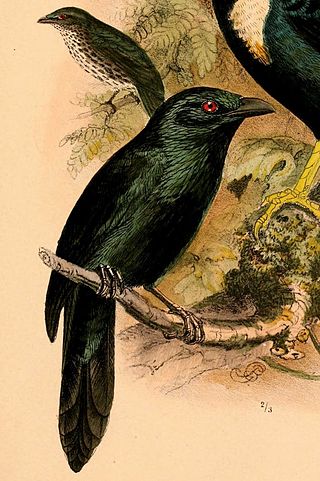
The Moluccan starling is a species of starling in the family Sturnidae. It is endemic to Indonesia.
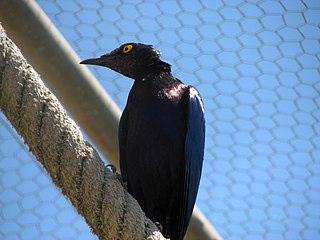
The yellow-eyed starling is a species of starling in the family Sturnidae. It is found in Indonesia and Papua New Guinea. Its natural habitat is subtropical or tropical moist lowland forests. It is threatened by habitat loss.

The Micronesian starling is a species of starling in the family Sturnidae. It is found in Micronesia, the Northern Mariana Islands, and Palau. Its natural habitats are subtropical or tropical dry forest and subtropical or tropical moist lowland forest.

The Asian glossy starling is a species of starling in the family Sturnidae. It is found in Bangladesh, Brunei, India, Indonesia, Malaysia, Myanmar, the Philippines, Singapore, Taiwan (introduced) and Thailand. Its natural habitats are subtropical or tropical moist lowland forest and subtropical or tropical mangrove forest. There is also a huge number of this species inhabiting towns and cities, where they take refuge in abandoned buildings and trees. They often move in large groups and are considered one of the noisiest species of birds. In the Philippines, it is known as kulansiyang, galansiyang, or kuling-dagat.
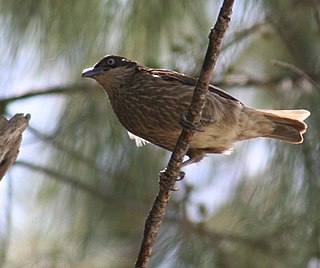
The Polynesian starling is a species of starling of the family Sturnidae. It is found in the Samoan Islands, Fiji, Niue, Tonga, the Santa Cruz Islands and Wallis and Futuna. Its natural habitats are subtropical or tropical dry forests and tropical moist forests. Various subspecies exist throughout this wide range, some darker in coloration and some lighter. Its call is a raspy buzz or rattle. Diet is fruit and insects.

The rusty-winged starling is a species of starling in the family Sturnidae. It is found in the Santa Cruz Islands and Vanuatu.
The Huahine starling is an extinct bird from the genus Aplonis within the starling family, Sturnidae. It was endemic to the island of Huahine, in the Society Islands of French Polynesia, and therefore had the easternmost distribution of all Aplonis species in the Pacific region.















